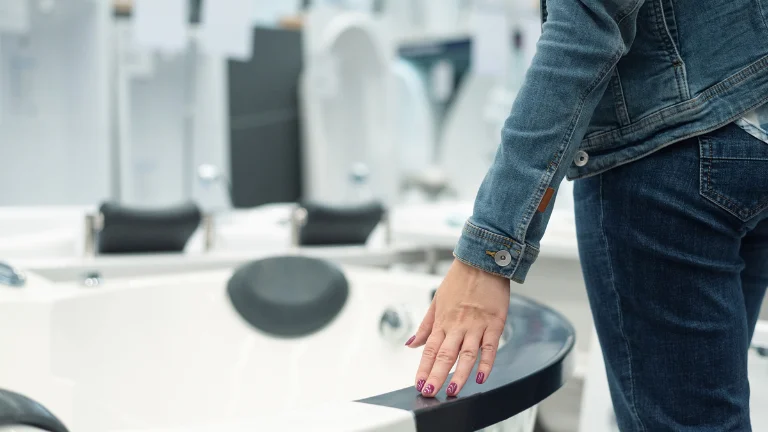Unveiling the Truth: Can You Contract an STD from a Hot Tub?
Can You Contract an STD from a Hot Tub? Find out the truth about the risks of getting an STD from a hot tub and how to prevent them. Learn about common hot tub diseases’ symptoms, causes, and treatments.
The short answer is: It is possible but unlikely to contract an STD from a hot tub unless you engage in sexual activities with an infected person while in the tub. Some STDs that can be contracted in this way are HPV and herpes.
Can You Contract an STD from a Hot Tub
The short answer is yes, it is possible, but it is unlikely. Let me explain why.
An STD, or sexually transmitted disease, is an infection passed from one person to another through sexual contact. Common STDs include chlamydia, gonorrhea, herpes, HIV, and syphilis. These infections are caused by bacteria, viruses, or parasites that can enter the body through the genitals, mouth, or anus.
When someone with an STD uses a hot tub, they can leave behind some of the bacteria, virus, or parasite that causes the infection in the water. If someone uses the same hot tub, they can come into contact with the infected water and potentially get infected themselves.
However, most STDs, such as gonorrhea, chlamydia, or hepatitis B, cannot survive in properly treated water. You can also get other diseases from a hot tub, such as lung, hot tub rash, Legionella infection, urinary tract infection, or allergic reaction.
If you think you might have contracted an STD or any other disease from a hot tub, you should get tested as soon as possible.
In this article, we’ll explore the factors contributing to the transmission of infections, the role of bacteria and chlorine, symptoms to watch out for, debunking common myths, and effective prevention measures.

The Role of Infection Transmission
Hot tubs create an environment where the risk of transmitting infections can be elevated. The warm water and the presence of various individuals may increase the chances of exposure to infectious agents.
However, it’s important to note that STDs are primarily transmitted through sexual activities involving direct contact with bodily fluids. The risk is relatively low in hot tubs compared to intimate sexual encounters.
What can I do if I contract with std from the hot tub?
The first thing you should do is see a doctor as soon as possible. A doctor can examine you, test you for STDs, and prescribe the appropriate treatment.
Some STDs can be cured with antibiotics, while others can be managed with antiviral drugs. The sooner you get tested and treated, the better your chances of avoiding complications or spreading the infection to others.
You should also inform your sexual partners, if any, about your situation and encourage them to get tested and treated. This is important to prevent reinfection and protect their health and the health of others.
You should practice safer sex by using condoms and dental dams whenever you have oral, vaginal, or anal sex, especially with new or casual partners.
Understanding Bacteria and Chlorine
Bacteria, including those associated with STDs, can survive in hot tubs. However, chlorine, a common disinfectant used in maintaining hot tub hygiene, plays a crucial role in minimizing the presence of harmful microorganisms.
Chlorine effectively kills most bacteria and viruses, reducing the risk of transmission. To optimize their sanitization properties, it’s vital to ensure that hot tubs are properly maintained and regularly chlorinated.
Recognizing Symptoms and Seeking Treatment
In the rare event that an STD is transmitted in a hot tub, it’s essential to be aware of the symptoms. Common symptoms of STDs include genital itching, pain, unusual discharge, and skin rashes.
If you experience any of these symptoms after using a hot tub, it’s essential to seek medical attention promptly. Early detection and medicine are critical to preventing further complications and the potential spread of the infection.
Myths vs. Facts about STDs in Hot Tubs
Let’s debunk some common myths surrounding STDs and hot tubs:
- Myth: Hot tubs can transmit STDs through water.
- Fact: STDs are mainly transmitted through direct sexual contact, not waterborne exposure in hot tubs.
- Myth: Chlorine eliminates all STDs in hot tubs.
- Fact: While chlorine helps reduce the presence of bacteria and viruses, it may not eliminate all types of STDs.
- Myth: You can’t contract an STD using a condom in a hot tub.
- Fact: Although condoms protect against many STDs, they may not offer full protection against all types of infections.
Minimizing the Risk of Infection
To minimize the danger of infection when utilizing a hot tub:
- Practice safe sexual behaviors outside the hot tub.
- Avoid utilizing a hot tub if you have open wounds or sores.
- Ensure the hot tub is properly maintained and chlorinated.
- Limit the time spent in the hot tub to avoid prolonged exposure.
Remember, these preventive measures can significantly reduce the risk of contracting an STD from a hot tub.
Can Anyone Get Chlamydia?
Yes, anyone who is sexually active can get chlamydia. It is one of the most common sexually transmitted diseases (STDs) and can affect people of all genders and ages. Here are some key points to understand about chlamydia:
How Chlamydia is Spread
- Sexual Contact: Chlamydia is primarily spread through vaginal, anal, or oral sex with someone who is infected.
- Mother to Baby: It can also be transmitted from an infected mother to her baby during childbirth.
Risk Factors
Certain behaviors and conditions can increase the risk of getting chlamydia:
- Multiple Partners: Having multiple sexual partners increases the likelihood of encountering an infected person.
- Unprotected Sex: Not using condoms consistently and correctly can lead to a higher risk of transmission.
- Previous STDs: Having had an STD before can make you more susceptible to contracting another one.
Symptoms
Many people with chlamydia do not experience symptoms, but when symptoms do occur, they can include:
- In Women: Abnormal vaginal discharge, burning sensation during urination, pain during intercourse, and bleeding between periods.
- In Men: Discharge from the penis, burning sensation during urination, and pain or swelling in one or both testicles.
Prevention
Preventing chlamydia involves taking several steps to reduce your risk:
- Use Condoms: Consistent and correct use of condoms during sex.
- Regular Testing: Regular STD testing for sexually active individuals.
- Mutual Monogamy: Being in a mutually monogamous relationship where both partners are tested and free of STDs.
Treatment
Chlamydia is treatable with antibiotics. It is essential to follow the treatment plan prescribed by a healthcare provider and to inform sexual partners so they can also get tested and treated if necessary.
Further Reading:
You can learn more about STDs and how to prevent them from these sources: Planned Parenthood, WebMD, and Mayo Clinic. These websites provide reliable and accurate information about the symptoms, causes, diagnosis, treatment, and prevention of various STDs. They also offer tips on how to talk to your doctor and your partner about STDs.
Summary:
This article explored whether you can contract an STD from a hot tub. While the risk of transmission is relatively low, it’s essential to understand the factors involved.
We discussed the role of bacteria and chlorine in hot tubs, recognized symptoms to watch out for, and debunked common myths surrounding STDs in this context.
By following preventive measures and practicing safe behaviors, you can enjoy a comforting soak in a hot tub without significant concern.
For additional information, visit Hot Tub Patio, or if you’re interested in more reading, see Hot Tub Health Benefits.
FAQs (Frequently Asked Questions):
Can I get an STD from a hot tub? The risk of contracting an STD from a hot tub is relatively low compared to intimate sexual encounters.
Does chlorine in hot tubs kill all bacteria and viruses? While chlorine is effective in reducing the presence of harmful microorganisms, it may not eliminate all types of STDs.
What are the common symptoms of STDs? Common symptoms include genital itching, pain, unusual discharge, and skin rashes.
Can using a condom in a hot tub prevent STD transmission? Condoms protect against many STDs but may not offer complete protection against all types of infections.
How can I minimize the risk of disease in a hot tub? Practice safe sexual behaviors outside the hot tub, avoid using it with open wounds or sores, ensure proper maintenance and chlorination, and limit exposure time.
Can you catch STDs from a hot tub? Yes, it is possible to contract a sexually transmitted infection (STI) from a hot tub. While it is not the most common way to contract an STI, it is still possible if someone with an STI uses the same hot tub. Some of the STIs that can be transmitted through contaminated water are chlamydia, gonorrhea, herpes, and trichomoniasis.
How likely is getting an STD from a hot tub? The likelihood of getting an STD from a hot tub depends on several factors, such as the type of STD, the amount of bacteria or virus in the water, the duration of exposure, the water temperature and pH, the presence of disinfectants, and the level of hygiene of the users.
Generally, the risk of getting an STD from a hot tub is low, especially if the hot tub is well-maintained and cleaned regularly. However, it is not zero, so it is always advisable to practice safe sex and get tested periodically.
What are the symptoms of getting an STD from a hot tub? The symptoms of getting an STD from a hot tub may vary depending on the type of infection. Some of the common symptoms are:
- Hot tub lung: fever, cough, difficulty breathing, and fatigue
- Hot tub rash: itchy, bumpy, red, or pus-filled blisters in and around hair follicles
- Legionella infection: fever, chills, cough, muscle aches, headache, and pneumonia
- Urinary tract infection (UTI): burning or pain when urinating, frequent or urgent requirement to urinate, blood in urine, lower abdominal pain, and fever
- Allergic reaction: skin rash, hives, itching, swelling, redness, and difficulty breathing
How can I prevent getting an STD from a hot tub? The best way to prevent getting an STD from a hot tub is to avoid sharing a hot tub with a person with an STI or whose status is unknown. If you do use a hot tub with others, make sure to:
- Shower before and after utilizing the hot tub
- Wear a clean swimsuit
- Avoid sexual contact in the hot tub
- Use condoms or dental dams if you have oral sex
- Check the water quality and disinfection level of the hot tub
- Document any signs of disease or illness to your doctor
Can you get chlamydia from being in a hot tub with someone who has it? No, you cannot get chlamydia from being in a hot tub with someone who has it. Chlamydia is a bacterial infection transmitted via sexual contact, such as anal, vaginal, or oral sex. It cannot survive in hot water or chlorine and does not spread through casual contact, such as sharing a bath or a towel.
Can you get chlamydia from a hot tub? No, you cannot get chlamydia from a hot tub. Chlamydia is not present in the water of a hot tub unless someone with an active infection ejaculates or bleeds into it. Even then, the heat and disinfectants in the water would quickly kill the bacteria. The only way to get chlamydia from a hot tub is to have unprotected sex with someone who has it in or near the hot tub.








